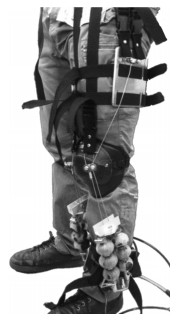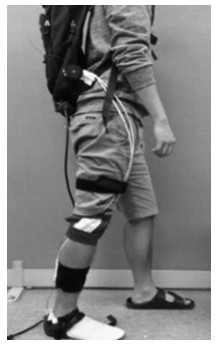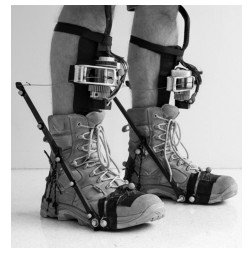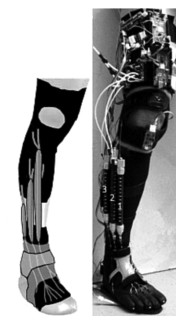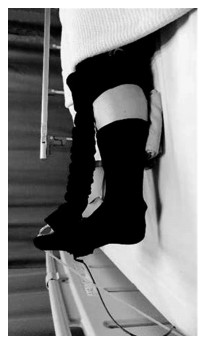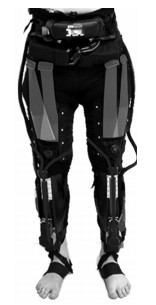-
摘要: 穿戴式柔性下肢助力机器人技术在康复医疗、助老助残、生活起居等方面具有广阔的应用前景, 具有质量轻、体积小、可穿戴性强、人机相容性好等优势.为促进我国柔性下肢助力机器人的研究和发展, 总结国内外在该领域的研究进展, 阐述了多种助力系统的组成、驱动原理和运动学信息等, 分析了各助力系统的辅助力/矩传递规律及其助力效果.同时, 对柔性下肢助力机器人所涉及的安全与可靠性、步态检测技术、驱动方式及控制策略、助力性能评估等关键技术进行了分析.在总结研究成果及分析关键技术的基础上, 指出柔性下肢助力机器人今后的发展方向、研究思路和面临的挑战.对于柔性下肢助力机器人及相关的研究工作, 具有一定的指导意义.Abstract: Soft wearable lower limb power-assisted robots have broad application prospects in the fields of rehabilitation, the elderly and the disabled, daily livings and other aspects of life, with the advantages of light weight, small volume, strong wearable feature, and human-machine compatibility. In order to promote the research and development of the soft wearable robots in China and summarize the research progress in those fields at home and abroad, the components, driving principle and kinematic information of various power assisted systems are discussed and the transfer law of the assistance force/moment and their power-assisted effect are analyzed. Moreover, key techniques such as the safety and reliability, gait detection, driving methods and control strategies, and power-assisted evaluation are analyzed in detail. On the basis of the above analysis, the future development, methods and challenges are presented, which has certain guidances for the related research works.
-
Key words:
- Soft limb lower power-assisted robot /
- wearable equipment /
- exoskeleton /
- hip joint /
- gait of lower limb
1) 本文责任编委 邓方 -
表 1 单关节助力型机器人
Table 1 Single joint power-assisted robot
序号 名称 驱动方式 驱动关节 质量(kg) 日本中央大学 / 1 行走助力机器人[29] 气动人工肌肉 髋 - 膝关节柔性助力服[37] 膝 2 日本信州大学[31] PVC凝胶驱动器 髋 0.6 轻质行走助力服 3 延边大学[26] 电机 髋 2.7 可穿戴柔性助力服 4 日本松下电器公司[27] 电机 髋 9.3 交叉线助力服 5 首尔国立大学[28] 电机 膝 - 膝关节助力服 6 日本冈山大学[36] 气压 膝 1.5 下肢助力裤 7 大连理工大学[39] 气压 膝 - 软式气动助力服 8 韩国高等科学技术研究所 电机 踝 - 柔性下肢助力外骨骼[41] 9 麻省理工学院[42] 电机 踝 10.1 移动式踝助力外骨骼 10 哈佛大学[43] 气动人工肌肉 踝 - 柔性仿生主动矫形器 11 新加坡国立大学[45] 气压 踝 - 柔性气动袜 表 2 多关节协同助力型机器人
Table 2 Multi-joint coordinated power-assisted robot
表 3 各驱动方式的优缺点
Table 3 The advantages and disadvantages of each drive
驱动类型 优点 缺点 电机驱动 1)标准化程度高 1)运动平衡性差 2)易实现自动化控制 2)易受到外界负载的影响 3)采用钢丝绳连接, 能量传递方便、信号传递迅速 3)需要输出大功率时, 电机体积大 4)无污染 气压驱动 1)质量轻、结构简单 1)难以密封 2)高功率/质量比 2)不适合低温工作 3)自然柔顺性 3)易压缩, 难以精确控制 4)粘性小, 无污染 4)在有负荷的作用下, 速度易发生变动 -
[1] Dollar A M, Herr H. Lower extremity exoskeletons and active orthoses: challenges and state-of-the-art. IEEE Transactions on Robotics, 2008, 24(1): 144-158 http://d.old.wanfangdata.com.cn/NSTLQK/NSTL_QKJJ023634830/ [2] 胡进, 侯增广, 陈翼雄, 张峰, 王卫群.下肢康复机器人及其交互控制方法.自动化学报, 2014, 40(11): 2377-2390 doi: 10.3724/SP.J.1004.2014.02377Hu Jin, Hou Zeng-Guang, Chen Yi-Xiong, Zhang Feng, Wang Wei-Qun. Lower limb rehabilitation robots and interactive control methods. Acta Automatica Sinica, 2014, 40(11): 2377-2390 doi: 10.3724/SP.J.1004.2014.02377 [3] Sankai Y. HAL: hybrid assistive limb based on cybernics. In: Proceedings of the Robotics Research. Springer Tracts in Advanced Robotics, vol. 66. Berlin, Heidelberg, Germany: Springer, 2010. 25-34 [4] Kawamoto H, Hayashi T, Sakurai T, Eguchi K, Sankai Y. Development of single leg version of HAL for hemiplegia. In: Proceedings of the Annual International Conference of the IEEE Engineering in Medicine and Biology Society. Minneapolis, USA: IEEE, 2009. 5038-5043 [5] Hocoma. Lokomat [Online], available: http://www.hocoma.com, July 24, 2014. [6] Freivogel S, Mehrholz J, Husak-Sotomayor T, Schmalohr D. Gait training with the newly developed "LokoHelp"-system is feasible for non-ambulatory patients after stroke, spinal cord and brain injury. A feasibility study. Brain Injury, 2008, 22(7-8): 625-632 doi: 10.1080/02699050801941771 [7] Li J F, Zhang Z Q, Tao C J, Ji R. Structure design of lower limb exoskeletons for gait training. Chinese Journal of Mechanical Engineering, 2015, 28(5): 878-887 doi: 10.3901/CJME.2015.0525.075 [8] 李剑锋, 徐成辉, 陶春静, 季润, 李世才, 张兆晶.基于3-UPS/RRR的并联踝关节康复机构及其性能分析.自动化学报, 2016, 42(12): 1794-1807 doi: 10.16383/j.aas.2016.c160144Li Jian-Feng, Xu Cheng-Hui, Tao Chun-Jing, Ji Run, Li Shi-Cai, Zhang Zhao-Jing. A parallel ankle rehabilitation mechanism and its performance analysis based on 3-UPS/RRR. Acta Automatica Sinica, 2016, 42(12): 1794-1807 doi: 10.16383/j.aas.2016.c160144 [9] 张雷雨, 李剑锋, 刘钧辉, 侯增广, 彭亮, 王卫群.上肢康复外骨骼的设计与人机相容性分析.机械工程学报, 2018, 54(5): 19-28 http://d.old.wanfangdata.com.cn/Periodical/jxgcxb201805003Zhang Lei-Yu, Li Jian-Feng, Liu Jun-Hui, Hou Zeng-Guang, Peng Liang, Wang Wei-Qun. Design and human-machine compatibility analysis of Co-Exos for upper-limb rehabilitation. Journal of Mechanical Engineering, 2018, 54(5): 19- 28 http://d.old.wanfangdata.com.cn/Periodical/jxgcxb201805003 [10] Aliman N, Ramli R, Haris S M. Design and development of lower limb exoskeletons: a survey. Robotics and Autonomous Systems, 2017, 95: 102-116 doi: 10.1016/j.robot.2017.05.013 [11] Schiele A, Van Der Helm F C T. Influence of attachment pressure and kinematic configuration on pHRI with wearable robots. Applied Bionics and Biomechanics, 2009, 6(2): 157-173 http://www.wanfangdata.com.cn/details/detail.do?_type=perio&id=4f120d9a734fcd41da6eaebe6bd0ca85 [12] Schiele A. Ergonomics of exoskeletons: objective performance metrics. In: Proceedings of the 3rd Joint EuroHaptics Conference and Symposium on Haptic Interfaces for Virtual Environment and Teleoperator Systems. Salt Lake City, UT, USA: IEEE, 2009. 103-108 [13] Viteckova S, Kutilek P, Jirina M. Wearable lower limb robotics: a review. Biocybernetics and Biomedical Engineering, 2013, 33(2): 96-105 doi: 10.1016/j.bbe.2013.03.005 [14] Pons J L. Rehabilitation exoskeletal robotics. IEEE Engineering in Medicine and Biology Magazine, 2010, 29(3): 57 -63 doi: 10.1109/MEMB.2010.936548 [15] Browning R C, Modica J R, Kram R, Goswami A. The effects of adding mass to the legs on the energetics and biomechanics of walking. Medicine and Science in Sports and Exercise, 2007, 39(3): 515-525 doi: 10.1249/mss.0b013e31802b3562 [16] Asbeck A T, De Rossi S M M, Galiana I, Ding Y, Walsh C J. Stronger, smarter, softer: next-generation wearable robots. IEEE Robotics and Automation Magazine, 2014, 21(4): 22-33 doi: 10.1109/MRA.2014.2360283 [17] Frost D M, Abdoli-E M, Stevenson J M. PLAD (personal lift assistive device) stiffness affects the lumbar flexion/ext- ension moment and the posterior chain EMG during symmetrical lifting tasks. Journal of Electromyography and Kinesiology, 2009, 19(6): E403-E412 doi: 10.1016/j.jelekin.2008.12.002 [18] Imamura Y, Tanaka T, Suzuki Y, Takizawa K, Yamanaka M. Analysis of trunk stabilization effect by passive power-assist device. Journal of Robotics and Mechatronics, 2014, 26(6): 791-798 doi: 10.20965/jrm.2014.p0791 [19] 李向攀, 韩建海, 郭冰菁, 张彦斌, 赵菲菲, 则次俊朗.基于柔性气压驱动器的可穿戴式腰部助力机器人研究.自动化学报, 2016, 42(12): 1849-1858 doi: 10.16383/j.aas.2016.c160211Li Xiang-Pan, Han Jian-Hai, Guo Bing-Jing, Zhang Yan-Bin, Zhao Fei-Fei, Noritsugu T. Development of wearable power assist robot for low back support using soft pneumatic actuators. Acta Automatica Sinica, 2016, 42(12): 1849- 1858 doi: 10.16383/j.aas.2016.c160211 [20] Asbeck A T, De Rossi S M M, Holt K G, Walsh C J. A biologically inspired soft exosuit for walking assistance. The International Journal of Robotics Research, 2015, 34(6): 744- 762 doi: 10.1177/0278364914562476 [21] Panizzolo F A, Galiana I, Asbeck A T, Christopher S, Kai S, Kenneth G H, et al. A biologically-inspired multi-joint soft exosuit that can reduce the energy cost of loaded walking. Journal of Neuroengineering and Rehabilitation, 2016, 13(1): 43 doi: 10.1186/s12984-016-0150-9 [22] Sasaki D, Noritsugu T, Takaiwa M. Development of pneumatic lower limb power assist wear driven with wearable air supply system. In: Proceedings of the 2013 IEEE/RSJ International Conference on Intelligent Robots and Systems. Tokyo, Japan: IEEE, 2013. 4440-4445 [23] Majidi C. Soft robotics: a perspective: current trends and prospects for the future. Soft Robotics, 2014, 1(1): 5-11 [24] Schiele A, Van der Helm F C T. Kinematic design to improve ergonomics in human machine interaction. IEEE Transactions on Neural Systems and Rehabilitation Engineering, 2006, 14(4): 456-469 doi: 10.1109/TNSRE.2006.881565 [25] Farris D J, Sawicki G S. The mechanics and energetics of human walking and running: a joint level perspective. Journal of the Royal Society Interface, 2012, 9(66): 110-118 doi: 10.1098/rsif.2011.0182 [26] Jin S H, Iwamoto N, Hashimoto K, Yamamoto M. Experimental evaluation of energy efficiency for a soft wearable robotic suit. IEEE Transactions on Neural Systems and Rehabilitation Engineering, 2017, 25(8): 1192-1201 doi: 10.1109/TNSRE.2016.2613886 [27] John S W, Murakami K, Komatsu M, Adachi S. Cross-wire assist suit concept, for mobile and lightweight multiple degree of freedom hip assistance. In: Proceedings of the International Conference on Rehabilitation Robotics. London, UK: IEEE, 2017. 387-393 [28] Mooney L M, Rouse E J, Herr H M. Autonomous exoskeleton reduces metabolic cost of walking. In: Proceedings of the 36th Annual International Conference of the IEEE Engineering in Medicine and Biology Society. Chicago, IL, USA: IEEE, 2014. 3065-3068 [29] Kawamura T, Takanaka K, Nakamura T, Osumi H. Development of an orthosis for walking assistance using pneumatic artificial muscle: a quantitative assessment of the effect of assistance. In: Proceedings of the 13th IEEE International Conference on Rehabilitation Robotics. Seattle, WA, USA: IEEE, 2013. 1-6 [30] Li Y, Hashimoto M. Design and prototyping of a novel lightweight walking assist wear using PVC gel soft actuators. Sensors and Actuators A: Physical, 2016, 239: 26-44 doi: 10.1016/j.sna.2016.01.017 [31] Li Y, Hashimoto M. PVC gel soft actuator-based wearable assist wear for hip joint support during walking. Smart Materials and Structures, 2017, 26(12): 125003 doi: 10.1088/1361-665X/aa9315 [32] Asbeck A T, Kai S, Walsh C J. Soft exosuit for hip assistance. Robotics and Autonomous Systems, 2015, 73: 102- 110 doi: 10.1016/j.robot.2014.09.025 [33] John S W, Komatsu M, Murakami K, Ozawa J, Yamamoto M. Soft hip walking assist experimental system featuring variable compliance control. In: Proceedings of the 2017 IEEE International Conference on Consumer Electronics. Las Vegas, NV, USA: IEEE, 2017. 400-401 [34] 李剑锋, 黄相强, 陶春静, 王飒, 季润.膝关节康复外骨骼构型综合与结构设计.哈尔滨工程大学学报, 2017, 38(4): 625-632 http://d.old.wanfangdata.com.cn/Periodical/hebgcdxxb201704020Li Jian-Feng, Huang Xiang-Qiang, Tao Chun-Jing, Wang Sa, Ji Run. Configuration synthesis and structure design of knee rehabilitation exoskeleton. Journal of Harbin Engineering University, 2017, 38(4): 625-632 http://d.old.wanfangdata.com.cn/Periodical/hebgcdxxb201704020 [35] Park D, In H, Lee H, Lee S, Koo I, Kang B B, et al. Preliminary study for a soft wearable knee extensor to assist physically weak people. In: Proceedings of the 11th International Conference on Ubiquitous Robots and Ambient Intelligence. Kuala Lumpur, Malaysia: IEEE, 2014. 136-137 [36] Sasaki D, Noritsugu T, Takaiwa M. Development of pneumatic lower limb power assist wear without exoskeleton. In: Proceedings of the 2012 IEEE/RSJ International Conference on Intelligent Robots and Systems. Algarve, Portugal: IEEE, 2012. 1239-1244 [37] Mohri S, Inose H, Yokoyama K, Yamada Y, Kikutani I, Nakamura T. Development of endoskeleton type knee auxiliary power assist suit using pneumatic artificial muscles. In: Proceedings of the 2016 IEEE International Conference on Advanced Intelligent Mechatronics. Alberta, Canada: IEEE, 2016. 107-112 [38] Mohri S, Inose H, Arakawa H, Yokoyama K, Yamada Y, Kikutani I, et al. Development of non-rotating joint drive type gastrocnemius-reinforcing power assist suit for squat lifting. In: Proceedings of the 2017 IEEE International Conference on Advanced Intelligent Mechatronics. Munich, Germany: IEEE, 2017. 851-856 [39] 张宪.软式可穿戴气动助力衣服的开发[硕士学位论文], 大连理工大学, 中国, 2015.Zhang Xian. Development of Soft Pneumatic Wearable Power Assist Suit [Master thesis], Dalian University of Technology, China, 2015. [40] 边辉, 刘艳辉, 梁志成, 赵铁石.并联2-RRR/UPRR踝关节康复机器人机构及其运动学.机器人, 2010, 32(1): 6-12 http://www.wanfangdata.com.cn/details/detail.do?_type=perio&id=jqr201001002Bian Hui, Liu Yan-Hui, Liang Zhi-Cheng, Zhao Tie-Shi. A novel 2-RRR/UPRR robot mechanism for ankle rehabilitation and its kinematics. Robot, 2010, 32(1): 6-12 http://www.wanfangdata.com.cn/details/detail.do?_type=perio&id=jqr201001002 [41] Park J, Park H, Kim J. Performance estimation of the lower limb exoskeleton for plantarflexion using surface electromyography (sEMG) signals. Journal of Biomechanical Science and Engineering, 2017, 12(2): 16-00595 http://www.wanfangdata.com.cn/details/detail.do?_type=perio&id=J-STAGE_2001499 [42] Mooney L M, Herr H M. Biomechanical walking mechanisms underlying the metabolic reduction caused by an autonomous exoskeleton. Journal of NeuroEngineering and Rehabilitation, 2016, 13: 4 doi: 10.1186/s12984-016-0111-3 [43] Park Y L, Chen B R, Young D, Stirling L, Wood R J, Goldfield E, et al. Bio-inspired active soft orthotic device for ankle foot pathologies. In: Proceedings of the 2011 IEEE/RSJ International Conference on Intelligent Robots and Systems. San Francisco, USA: IEEE, 2011. 4488-4495 [44] Wehner M, Park Y L, Walsh C, Nagpal R, Wood R J, Moore T, et al. Experimental characterization of components for active soft orthotics. In: Proceedings of the 4th IEEE RAS/EMBS International Conference on Biomedical Robotics and Biomechatronics. Roma, Italy: IEEE, 2012. 1586-1592 [45] Low F Z, Yeow R C H, Yap H K, Lim J H. Study on the use of soft ankle-foot exoskeleton for alternative mechanical prophylaxis of deep vein thrombosis. In: Proceedings of the 2015 IEEE International Conference on Rehabilitation Robotics. Singapore, Singapore: IEEE, 2015. 589-593 [46] Schmidt K, Duarte J E, Grimmer M, Sancho-Puchades A, Wei H Q, Easthope C S, et al. The myosuit: bi-articular anti-gravity exosuit that reduces hip extensor activity in sitting transfers. Frontiers in Neurorobotics, 2017, 11: 57 doi: 10.3389/fnbot.2017.00057 [47] Hashimoto Y, Nakanishi Y, Saga N, Nagase J Y, Satoh T. Development of gait assistive device using pneumatic artificial muscle. In: Proceedings of the Joint 8th International Conference on Soft Computing and Intelligent Systems and 17th International Symposium on Advanced Intelligent Systems. Sapporo, Japan: IEEE, 2016. 710-713 [48] Wehner M, Quinlivan B, Aubin P M, Martinez-Villalpando E, Baumann M, Stirling L, et al. A lightweight soft exosuit for gait assistance. In: Proceedings of the 2013 IEEE International Conference on Robotics and Automation. Karlsruhe, Germany: IEEE, 2013. 3362-3369 [49] Bartenbach V, Schmidt K, Naef M, Wyss D, Riener R. Concept of a soft exosuit for the support of leg function in rehabilitation. In: Proceedings of the 2015 IEEE International Conference on Rehabilitation Robotics. Singapore, Singapore: IEEE, 2015. 125-130 [50] Sasaki D, Takaiwa M. Development of pneumatic power assist wear to reduce physical burden. In: Proceedings of the 2014 IEEE/SICE International Symposium on System Integration. Tokyo, Japan: IEEE, 2015. 626-631 [51] Li J F, Li S C, Zhang L Y, Tao C J, Ji R. Position solution and kinematic interference analysis of a novel parallel hip-assistive mechanism. Mechanism and Machine Theory, 2018, 120: 265-287 doi: 10.1016/j.mechmachtheory.2017.10.002 [52] Guo X H, Huang Y, Cai X, Liu C X, Liu P. Capacitive wearable tactile sensor based on smart textile substrate with carbon black/silicone rubber composite dielectric. Measurement Science and Technology, 2016, 27(4): 045105 doi: 10.1088/0957-0233/27/4/045105 [53] Shu L, Hua T, Wang Y Y, Li Q, Feng D D, Tao X M. In-shoe plantar pressure measurement and analysis system based on fabric pressure sensing array. IEEE Transactions on Information Technology in Biomedicine, 2010, 14(3): 767-775 doi: 10.1109/TITB.2009.2038904 [54] Mueller J K P, Evans B M, Ericson M N, Farquhar E, Lind R, Kelley K, et al. A mobile motion analysis system using inertial sensors for analysis of lower limb prosthetics. In: Proceedings of the Future of Instrumentation International Workshop. Oak Ridge, TN, USA: IEEE, 2011. 59-62 [55] Hu X Y, Yao C, Soh G S. Performance evaluation of lower limb ambulatory measurement using reduced inertial measurement units and 3R gait model. In: Proceedings of the 14th IEEE International Conference on Rehabilitation Robotics. Singapore, Singapore: IEEE, 2015. 549-554 [56] Triloka J, Senanayake S M N A, Lai D. Neural computing for walking gait pattern identification based on multi-sensor data fusion of lower limb muscles. Neural Computing and Applications, 2017, 28(S1): 65-77 doi: 10.1007/s00521-016-2312-x [57] Meng M, Luo Z Z, She Q S, Ma Y L. Automatic recognition of gait mode from EMG signals of lower limb. In: Proceedings of the 2nd International Conference on Industrial Mechatronics and Automation. Wuhan, China: IEEE, 2010. 282-285 [58] Quinlivan B T, Lee S, Malcolm P, Rossi D M, Grimmer M, Siviy C, et al. Assistance magnitude versus metabolic cost reductions for a tethered multiarticular soft exosuit. Science Robotics, 2017, 2(2): eaah4416 doi: 10.1126/scirobotics.aah4416 -





 下载:
下载:




